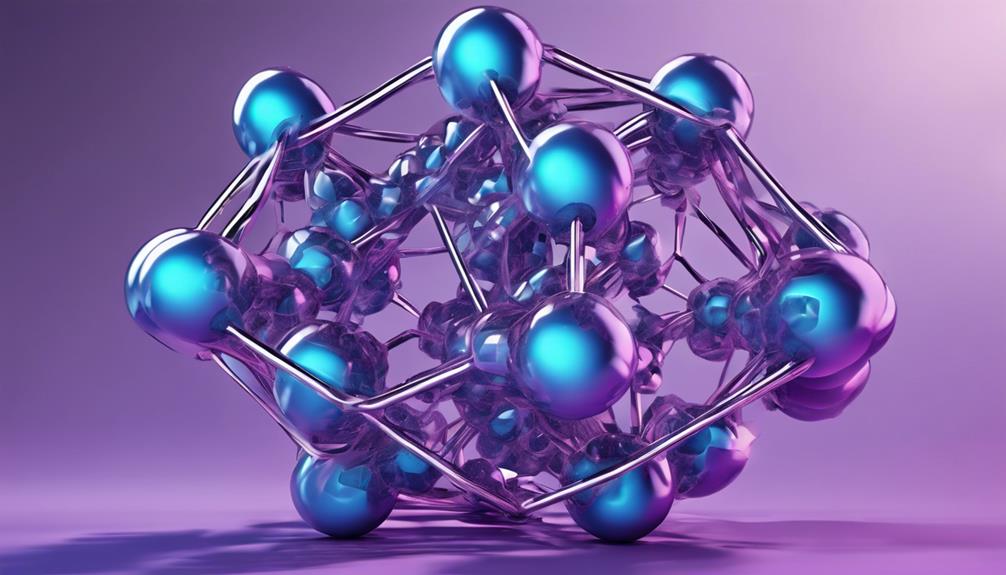As we delve into the world of ionic compounds, we're discovering that the strength of lattice energy is influenced by a delicate interplay of factors. Ionic radii, charge, crystal structure, and temperature all play a vital role in determining the stability of these compounds. We're finding that similar ionic radii lead to higher stability, while smaller radii result in higher lattice energies. The organization of the crystal lattice and temperature also have a significant impact. By understanding these factors, we can reveal the secrets of lattice energy strength and gain insights into the properties of ionic compounds. And there's more to uncover, so let's dive deeper into the intricacies of lattice energy.
Key Takeaways
- Ionic radii significantly impact lattice energy, with similar radii leading to higher stability and smaller radii resulting in higher lattice energies.
- Ionic charge determines electrostatic attraction strength, with higher charges leading to stronger attractions and more stable crystal structures.
- Crystal structure and packing play a crucial role in lattice energy, with close packing and symmetry influencing electrostatic attractions and overall stability.
- Temperature affects lattice energy and solubility, with increased temperatures weakening lattice energy and decreasing solubility.
- Understanding the interplay of these factors is essential for predicting the properties and stability of ionic compounds.
Factors Influencing Lattice Energy

When it comes to lattice energy, several crucial factors come into play, and understanding their influences is essential for grasping the stability and properties of ionic compounds.
We've found that the size of ions greatly affects lattice energy, with smaller ions resulting in stronger attraction and higher lattice energy.
The magnitude of ionic charge also plays a significant role, as higher charges lead to stronger electrostatic attraction and higher lattice energy.
Additionally, crystal structure and packing arrangements have a profound impact, with well-organized and tightly packed lattices exhibiting higher lattice energy.
Temperature, too, affects lattice energy, with increased temperatures leading to decreased lattice energy.
Ionic Radii and Stability

We find that ionic radii play a pivotal role in determining lattice energy, with similar ionic radii leading to higher lattice energy and stability. This is because similar-sized ions can pack more efficiently, resulting in stronger electrostatic attractions and a more stable crystal structure.
Smaller ionic radii result in higher lattice energies and melting points, as seen in compounds like NaCl.
Conversely, larger ionic radii lead to lower lattice energies and melting points, as observed in compounds like KI.
Understanding the relationship between ionic radii and lattice energy is fundamental in predicting the properties of ionic compounds.
Charge and Electrostatic Attraction

As we explore the factors influencing lattice energy, it becomes clear that the magnitude of ionic charge plays a significant role in determining the strength of electrostatic attraction between ions.
The higher the ionic charge, the stronger the electrostatic attraction, resulting in higher lattice energy. This is because ions with higher charges have a greater number of electrons, which increases the electrostatic force between them.
As a result, compounds with higher ionic charges form more stable crystal structures with higher lattice energies. This, in turn, affects their melting points and solubility, with higher lattice energies corresponding to higher melting points and lower solubility.
Understanding the impact of ionic charge on lattice energy is essential for predicting the properties of ionic compounds.
Crystal Structure and Packing

As we dig deeper into the factors affecting lattice energy strength, we find that the organization of ions in a crystal lattice greatly influences the lattice energy of an ionic compound. This includes their density of packing and symmetry. The way ions are packed and arranged in a crystal lattice can significantly impact the strength of the electrostatic attractions between them.
Well-structured and densely packed lattices result in stronger interatomic forces, leading to higher lattice energies.
Symmetry in crystal structures also plays an essential role in determining lattice energy, with more symmetrical structures typically exhibiting higher lattice energies.
Close packing of ions in a crystal lattice enables stronger interactions, resulting in higher lattice energies and increased stability.
Temperature and Solubility Effects

Raising the temperature of an ionic compound can weaken its lattice energy to a significant extent, leading to decreased solubility and altered chemical behavior.
We've learned that lattice energy is the measure of the strength of ionic bonds within a compound. As temperature increases, the vibrations of the ions also increase, causing the lattice energy to decrease. This, in turn, affects the solubility of the compound.
Weakened lattice energy can lead to decreased solubility, making it more challenging for the compound to dissolve in a solvent. Understanding the impact of temperature on lattice energy is essential in predicting the chemical behavior of ionic compounds.
Importance of Lattice Energy

We recognize that lattice energy plays a vital role in determining the stability and reactivity of ionic compounds, making it an essential factor in understanding their properties and behavior.
As chemists, we need to accurately rank lattice energies to predict the chemical behavior of compounds. This is pivotal in understanding the stability and reactivity of ionic compounds, which in turn affects their properties and behavior.
- Enables comparison of lattice energies for different compounds
- Provides insights into properties of ionic compounds
- Supports decision-making in chemical research and applications
Predicting Compound Properties

TEXT:
The first step in planning a successful event is to establish a clear goal and purpose. This will help guide all other decisions and ensure that the event is aligned with its intended outcome.
The next important aspect to consider is the budget. Determining how much you can afford to spend will dictate many elements of the event, from the venue choice to the catering options.
Once the goal and budget are set, the next step is to create a timeline. This will outline the tasks that need to be completed and when they need to be done to ensure everything runs smoothly on the day of the event.
After the timeline is in place, it's time to start choosing the specific details of the event, such as the theme, decorations, and entertainment. These elements should all work together to create a cohesive and memorable experience for attendees.
Finally, don't forget to promote the event to ensure a good turnout. Utilize social media, email marketing, and word-of-mouth to generate excitement and interest in your event.
Frequently Asked Questions
How Does Lattice Energy Affect the Hardness of Ionic Compounds?
We're exploring how lattice energy impacts the hardness of ionic compounds. We've found that higher lattice energy typically results in harder compounds, as stronger electrostatic attractions between ions create a more rigid structure.
Can Lattice Energy Be Used to Predict the Toxicity of a Compound?
'As we explore the mystical domain of lattice energy, we wonder: can it foretell a compound's toxicity? While there's no direct connection, lattice energy's impact on solubility and stability can indirectly affect a compound's toxic potential, suggesting a subtle connection.'
Is Lattice Energy Related to the Color of an Ionic Compound?
'We're investigating whether lattice energy relates to an ionic compound's color. While lattice energy affects a compound's stability and reactivity, it doesn't directly influence its color, which is primarily determined by electronic shifts.'
How Does Lattice Energy Influence the Magnetic Properties of a Compound?
"We explore how lattice energy affects a compound's magnetic properties. Stronger lattice energy often leads to weaker magnetic interactions, as tightly packed ions reduce magnetic moment, resulting in weaker magnetism or even diamagnetism."
Can Lattice Energy Be Used to Design New Materials With Specific Properties?
We can indeed leverage lattice energy to design new materials with specific properties, as it directly impacts a compound's stability, solubility, and reactivity, allowing us to tailor materials for desired applications.
How does the lattice energy of Al2O3 contribute to the overall strength of lattice energy?
The al2o3 lattice energy insights explain how the strong electrostatic forces between ions in the lattice structure contribute to the overall strength of the lattice energy. These insights highlight the significance of the arrangement of ions and the magnitude of the charges in determining the stability and strength of the lattice.
Conclusion
As we wrap up our exploration of lattice energy, we've revealed the hidden dynamics that govern the world of ionic compounds. It's clear that lattice energy is the unsung hero, working behind the scenes to dictate the properties of these compounds.
By grasping the intricate dance of ionic radii, charge, crystal structure, and temperature, we can reveal the secrets of these mysterious substances, and uncover the hidden patterns that govern their behavior.










